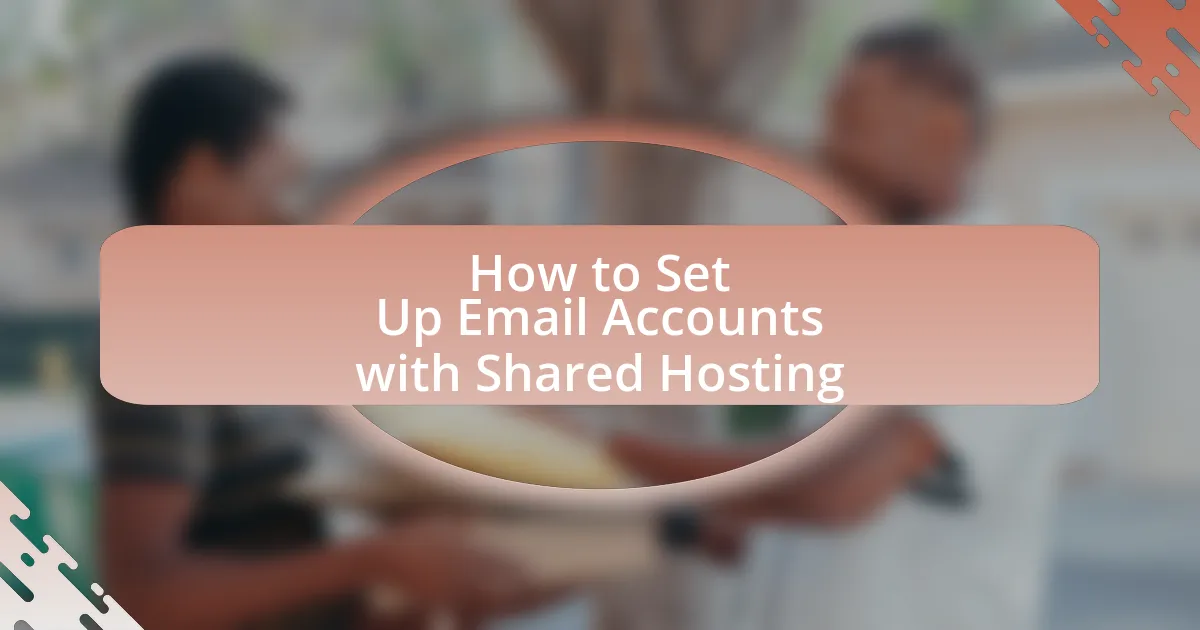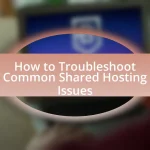Shared hosting is a web hosting service that allows multiple websites to share a single server’s resources, and it often includes email services as part of the package. This article provides a comprehensive guide on setting up email accounts using shared hosting, detailing the process from accessing the hosting control panel to configuring email settings such as SMTP and IMAP. It also addresses common issues that may arise during setup, best practices for managing email accounts, and resources for further assistance. Key features of email hosting in shared environments, the differences between personal and business email accounts, and security measures to protect email accounts are also discussed, ensuring users can effectively manage their email communications.
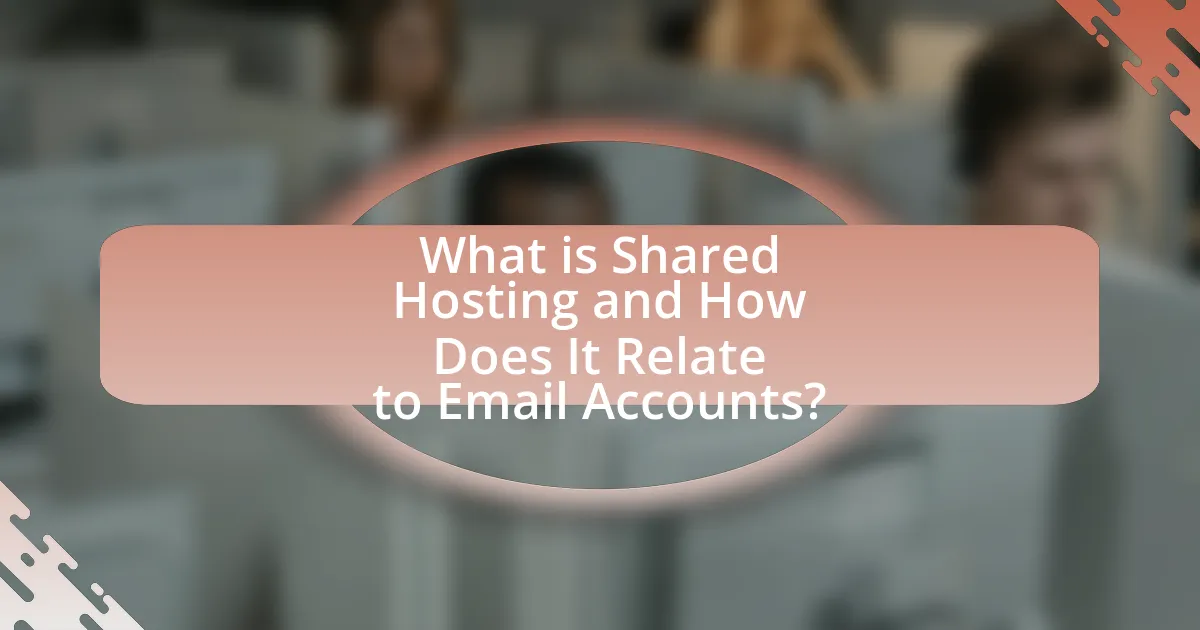
What is Shared Hosting and How Does It Relate to Email Accounts?
Shared hosting is a web hosting service where multiple websites are hosted on a single server, sharing its resources such as CPU, RAM, and disk space. This type of hosting relates to email accounts because many shared hosting providers include email services as part of their packages, allowing users to create custom email addresses associated with their domain names. For example, if a business has a website hosted on a shared server, it can set up email accounts like [email protected], leveraging the same server infrastructure for both web and email functionalities. This integration simplifies management and reduces costs for users, as they can handle both website and email services through a single provider.
How does shared hosting work for email services?
Shared hosting for email services allows multiple users to utilize a single server to manage their email accounts. In this setup, the hosting provider allocates a portion of server resources to each user, enabling them to create and manage email addresses associated with their domain. This arrangement is cost-effective, as users share the server’s maintenance and operational costs, making it accessible for small businesses and individuals. Shared hosting typically includes features such as webmail access, email forwarding, and spam filtering, which enhance the user experience. The reliability of shared hosting for email services is supported by the fact that many providers offer 99.9% uptime guarantees, ensuring that users can access their email consistently.
What are the key features of email hosting in shared environments?
Email hosting in shared environments typically includes features such as multiple email accounts, webmail access, and storage limits. Shared hosting allows users to create several email addresses under a single domain, facilitating communication for businesses and organizations. Webmail access enables users to manage their emails through a browser interface, enhancing convenience. Additionally, storage limits are often defined per account, ensuring efficient use of server resources. These features collectively support effective email management while maintaining cost efficiency in shared hosting scenarios.
How does shared hosting impact email performance and reliability?
Shared hosting negatively impacts email performance and reliability due to resource limitations and potential server congestion. In shared hosting environments, multiple users share the same server resources, which can lead to slower email delivery times and increased downtime during peak usage periods. Additionally, if one user on the shared server experiences issues, it can affect the email services of all users on that server, resulting in unreliable email performance. Studies have shown that shared hosting can lead to higher rates of email bounce-backs and delays, as the server may struggle to handle the volume of outgoing emails efficiently.
What types of email accounts can be set up with shared hosting?
Shared hosting typically allows for the setup of several types of email accounts, including standard email accounts, catch-all email accounts, and forwarder email accounts. Standard email accounts provide individual email addresses for users, catch-all accounts receive all emails sent to the domain regardless of the specific address, and forwarder accounts redirect emails from one address to another. These functionalities are commonly supported by shared hosting providers, enabling users to manage their email communications effectively.
What are the differences between personal and business email accounts?
Personal email accounts are primarily designed for individual use, while business email accounts are tailored for professional communication within organizations. Personal email accounts typically offer limited storage, fewer security features, and may include advertisements, whereas business email accounts provide enhanced storage, advanced security protocols, and custom domain names that reflect the company’s brand. Additionally, business email accounts often include collaboration tools and customer support, which are not standard in personal accounts. These distinctions are crucial for users to choose the appropriate type of email account based on their needs.
How can multiple email accounts be managed under one shared hosting plan?
Multiple email accounts can be managed under one shared hosting plan by utilizing the control panel provided by the hosting service, such as cPanel or Plesk. These control panels typically allow users to create, delete, and manage multiple email accounts associated with their domain. For instance, a user can set up distinct email addresses like [email protected], [email protected], and [email protected] through the email management section of the control panel. This functionality is supported by the fact that most shared hosting plans include email hosting features, enabling users to handle various accounts without needing separate hosting services.
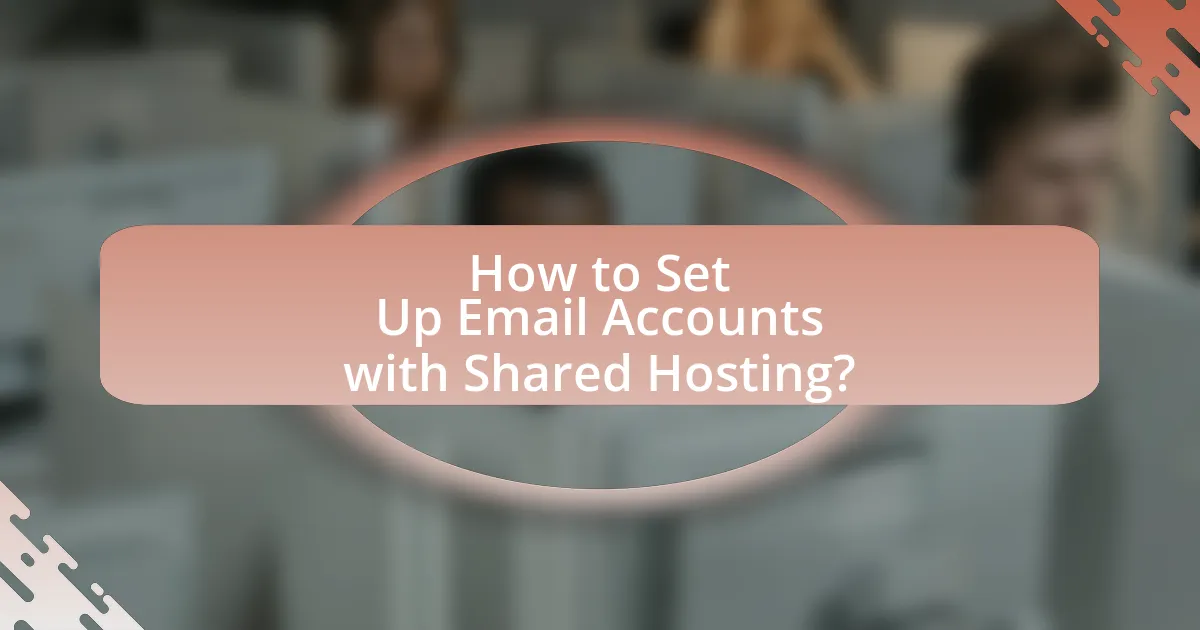
How to Set Up Email Accounts with Shared Hosting?
To set up email accounts with shared hosting, access your hosting control panel, typically cPanel, and locate the “Email Accounts” section. From there, you can create a new email account by entering the desired email address, selecting the domain, and setting a password. After saving the settings, the email account will be created, allowing you to send and receive emails using that address. This process is standard across many shared hosting providers, ensuring that users can easily manage their email accounts alongside their web hosting services.
What are the initial steps to create an email account in shared hosting?
To create an email account in shared hosting, first, log in to your hosting control panel, such as cPanel or Plesk. Next, locate the “Email Accounts” section, where you can add a new email account by entering the desired email address and password. After filling in the required fields, click “Create” or “Add Account” to finalize the process. This method is standard across most shared hosting providers, ensuring that users can easily set up email accounts as part of their hosting services.
How do you access the hosting control panel?
To access the hosting control panel, you typically navigate to the URL provided by your hosting provider, which often includes “cpanel” or “admin” in the address. After entering the URL, you will need to log in using the credentials supplied during your hosting account setup. This method is standard across many hosting services, ensuring that users can manage their accounts effectively.
What information is needed to create a new email account?
To create a new email account, the required information typically includes the user’s name, desired email address, password, and sometimes additional details such as a recovery email or phone number. This information is essential for account identification, security, and recovery options. Email service providers often require these details to ensure proper account setup and user authentication.
What configurations are necessary for email account setup?
To set up an email account, the necessary configurations include the email address, password, incoming mail server (IMAP or POP3), outgoing mail server (SMTP), and port numbers for both incoming and outgoing servers. The email address and password authenticate the user, while the incoming and outgoing mail servers facilitate the sending and receiving of emails. For example, IMAP typically uses port 993 for secure connections, while POP3 uses port 995, and SMTP commonly uses port 587 for secure email sending. These configurations ensure proper communication between the email client and the email server, enabling successful email functionality.
How do you configure email settings such as SMTP and IMAP?
To configure email settings such as SMTP and IMAP, access your email client’s settings and input the required server information. For SMTP, use the outgoing mail server address, typically in the format smtp.yourdomain.com, along with the correct port number, usually 587 or 465, and your email account credentials. For IMAP, enter the incoming mail server address, often imap.yourdomain.com, with the standard port 993 for SSL or 143 for non-SSL connections, also including your email account credentials. This configuration allows your email client to send and receive messages effectively, ensuring proper communication through your shared hosting service.
What security measures should be taken during setup?
During setup, implement strong password policies to ensure that all accounts are protected against unauthorized access. Strong passwords should include a mix of uppercase and lowercase letters, numbers, and special characters, and should be at least 12 characters long. Additionally, enable two-factor authentication (2FA) for an extra layer of security, which requires users to provide a second form of verification beyond just the password. Regularly update software and applications to patch vulnerabilities, as outdated systems are prime targets for attacks. Furthermore, configure email accounts to use secure protocols such as SSL/TLS for encryption during data transmission, which protects sensitive information from interception. These measures collectively enhance the security of email accounts set up on shared hosting environments.
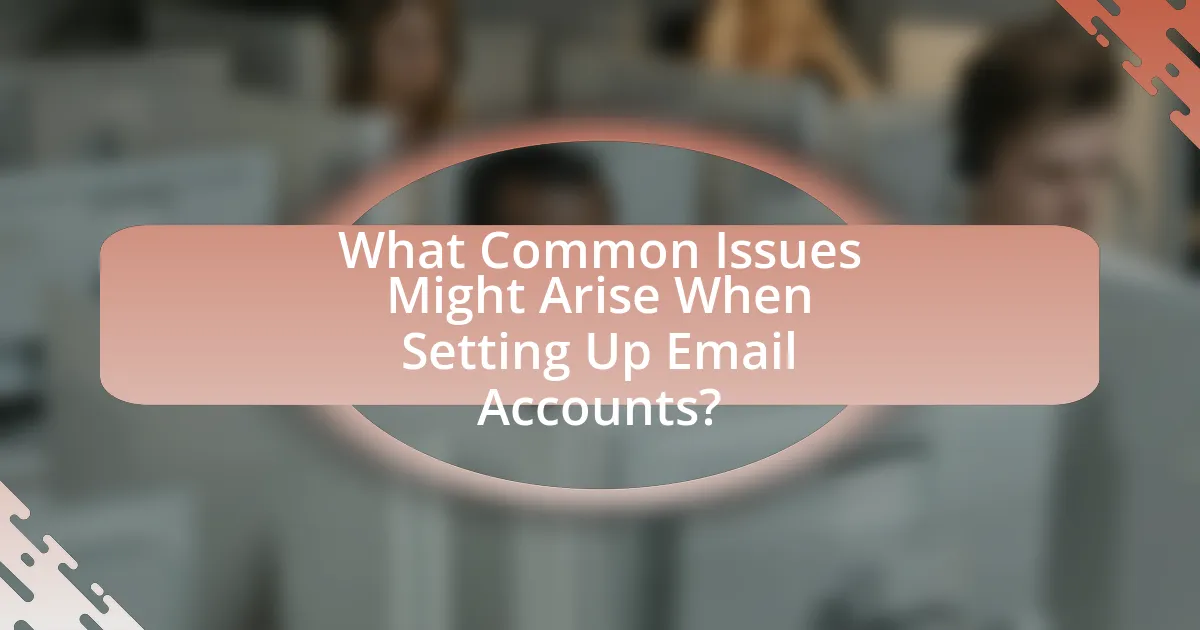
What Common Issues Might Arise When Setting Up Email Accounts?
Common issues that might arise when setting up email accounts include incorrect server settings, authentication failures, and domain verification problems. Incorrect server settings, such as using the wrong incoming or outgoing mail server addresses, can prevent successful email configuration. Authentication failures often occur due to incorrect usernames or passwords, leading to an inability to send or receive emails. Additionally, domain verification problems may arise if the domain is not properly linked to the email service, resulting in emails being undeliverable. These issues are frequently encountered during the setup process and can hinder effective email communication.
What troubleshooting steps can be taken for email setup problems?
To troubleshoot email setup problems, first verify the email account settings, including the incoming and outgoing server addresses, port numbers, and authentication methods. Incorrect settings are a common cause of email issues. Next, check the internet connection to ensure it is stable and functioning, as connectivity problems can prevent email access. Additionally, review any firewall or antivirus settings that may block email traffic, as these can interfere with the email client’s ability to connect to the server. Finally, consult the email service provider’s documentation for specific troubleshooting steps or contact their support for assistance, as they can provide tailored solutions based on their system configurations.
How can you resolve issues with email delivery and spam filters?
To resolve issues with email delivery and spam filters, ensure that your email server is properly configured with SPF, DKIM, and DMARC records. These authentication methods help verify that your emails are legitimate and reduce the likelihood of being marked as spam. According to a study by Return Path, emails that pass these authentication checks have a 99% higher chance of reaching the inbox rather than the spam folder. Additionally, regularly monitor your sender reputation and avoid using spam-triggering keywords in your content to further enhance deliverability.
What should you do if you forget your email account password?
If you forget your email account password, you should initiate the password recovery process through your email service provider’s website. Most providers offer a “Forgot Password?” link on the login page that guides you through steps to reset your password, typically involving verification via a secondary email or phone number associated with the account. This method is effective because it ensures that only the account owner can reset the password, maintaining account security.
What best practices should be followed for managing email accounts on shared hosting?
To effectively manage email accounts on shared hosting, implement strong password policies, regularly update passwords, and utilize two-factor authentication. Strong passwords reduce the risk of unauthorized access, while regular updates prevent potential breaches. Two-factor authentication adds an additional layer of security, making it significantly harder for attackers to gain access. Additionally, monitor email account activity for unusual behavior, as this can help identify potential security threats early. Regularly back up email data to prevent loss in case of server issues or accidental deletions. Following these practices ensures a secure and efficient email management system on shared hosting platforms.
How can you ensure email account security and privacy?
To ensure email account security and privacy, use strong, unique passwords and enable two-factor authentication (2FA). Strong passwords should be at least 12 characters long, combining letters, numbers, and symbols, which significantly reduces the risk of unauthorized access. According to a study by the National Institute of Standards and Technology, using 2FA can block 99.9% of automated attacks, providing an additional layer of security. Regularly updating passwords and being cautious of phishing attempts further enhances email security.
What are the recommended maintenance tips for email accounts?
To maintain email accounts effectively, regularly update passwords, enable two-factor authentication, and monitor account activity. Regularly updating passwords enhances security by reducing the risk of unauthorized access, while two-factor authentication adds an extra layer of protection. Monitoring account activity helps identify any suspicious behavior, allowing for prompt action. According to a 2021 report by the Cybersecurity & Infrastructure Security Agency, 80% of data breaches involve compromised passwords, underscoring the importance of these maintenance practices.
What resources are available for further assistance with email setup?
For further assistance with email setup, users can access several resources including official documentation from their email service provider, online forums, and customer support services. Official documentation typically provides step-by-step guides tailored to specific email clients and hosting environments, ensuring users follow the correct procedures. Online forums, such as those on Reddit or specialized tech communities, allow users to seek advice from experienced individuals who have faced similar issues. Additionally, customer support services offer direct help, often through live chat or phone support, which can resolve specific problems quickly. These resources collectively enhance the email setup experience by providing reliable information and support.
Where can you find tutorials and guides for email account management?
You can find tutorials and guides for email account management on websites such as the official support pages of email service providers like Gmail, Outlook, and Yahoo, as well as on tech tutorial sites like How-To Geek and Lifewire. These resources provide step-by-step instructions and troubleshooting tips for managing email accounts effectively. For example, Gmail’s Help Center offers comprehensive guides on account settings, security, and organization features, ensuring users can navigate their email management tasks efficiently.
How can you contact customer support for hosting-related email issues?
To contact customer support for hosting-related email issues, you can typically reach out via the support ticket system provided by your hosting provider, or by using their dedicated customer support phone number. Most hosting companies also offer live chat options on their websites for immediate assistance. For example, companies like Bluehost and SiteGround provide 24/7 support through these channels, ensuring that users can resolve email issues promptly.
